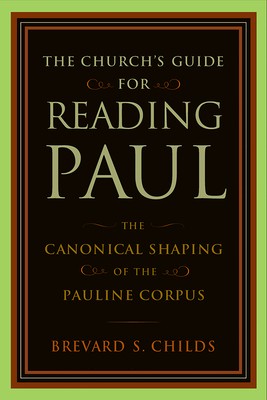
- We will send in 10–14 business days.
- Author: Brevard S Childs
- Publisher: William B. Eerdmans Publishing Company
- ISBN-10: 0802862780
- ISBN-13: 9780802862785
- Format: 16.1 x 22.8 x 1.9 cm, minkšti viršeliai
- Language: English
- SAVE -10% with code: EXTRA
Reviews
Description
Brevard Childs here turns his sharp scholarly eye to the works of the apostle Paul and makes an unusual argument: the New Testament was canonically shaped, its formation a hermeneutical exercise in which its anonymous apostles and postapostolic editors collected, preserved, and theologically shaped the material in order for the evangelical traditions to serve successive generations of Christians.
Childs contends that within the New Testament the Pauline corpus stands as a unit bookended by Romans and the Pastoral Epistles. He assigns an introductory role to Romans, examining how it puts the contingencies of Paul's earlier letters into context without sacrificing their particularity. At the other end, the Pastoral Epistles serve as a concluding valorization of Paul as the church's doctrinal model. By considering Paul's works as a whole, Childs offers a way to gain a fuller understanding of the individual letters.EXTRA 10 % discount with code: EXTRA
The promotion ends in 22d.21:27:10
The discount code is valid when purchasing from 10 €. Discounts do not stack.
- Author: Brevard S Childs
- Publisher: William B. Eerdmans Publishing Company
- ISBN-10: 0802862780
- ISBN-13: 9780802862785
- Format: 16.1 x 22.8 x 1.9 cm, minkšti viršeliai
- Language: English English
Brevard Childs here turns his sharp scholarly eye to the works of the apostle Paul and makes an unusual argument: the New Testament was canonically shaped, its formation a hermeneutical exercise in which its anonymous apostles and postapostolic editors collected, preserved, and theologically shaped the material in order for the evangelical traditions to serve successive generations of Christians.
Childs contends that within the New Testament the Pauline corpus stands as a unit bookended by Romans and the Pastoral Epistles. He assigns an introductory role to Romans, examining how it puts the contingencies of Paul's earlier letters into context without sacrificing their particularity. At the other end, the Pastoral Epistles serve as a concluding valorization of Paul as the church's doctrinal model. By considering Paul's works as a whole, Childs offers a way to gain a fuller understanding of the individual letters.

Reviews